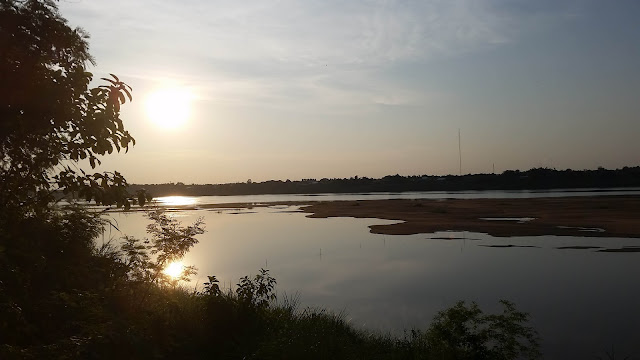Our next destination was a city called Kampong Cham. It was a half day drive from Siem Reap, but I never did really figure out what distinguished this city from any other in Cambodia and why it was on our itinerary. I did find out that the word 'cham' refers to an ethnic group of Cambodians (Khmer), some of whom were exposed to Islam, so it seems it has a higher Muslim population than the rest of Cambodia.
The city is located on the Mekong River - so this body of water has been a constant in my journey to date. According to Wiki it is the third largest city in Cambodia, known for its French Colonial architecture. Sadly I did not detect any of that, so can't show it to you. We arrived in time for lunch, then my mission was to find some mouthwash, as a tooth of mine was starting to act up and I thought mouthwash might help. Colonial architecture was not on my radar.
The city is located on the Mekong River - so this body of water has been a constant in my journey to date. According to Wiki it is the third largest city in Cambodia, known for its French Colonial architecture. Sadly I did not detect any of that, so can't show it to you. We arrived in time for lunch, then my mission was to find some mouthwash, as a tooth of mine was starting to act up and I thought mouthwash might help. Colonial architecture was not on my radar.
But all was not lost! Most of the group arranged with our guide, Sareth (in the red shirt), to venture out on bicycles to ride across a bamboo bridge later in the afternoon. It is a temporary structure that will be washed away by the monsoons in a month or so, to be replaced by a ferry in the wet season.
The bridge leads to an island in the Mekong called Koh Paen. Being a veteran of the bamboo bridge in Luang Prabang, I was confident I could handle it! So off we set! I was a little less certain when I saw that this bridge was not just a walking bridge, but also a motorbike, car and horse wagon bridge...
......along with pedestrians! It looked solid enough - as it should for a car bridge - but the covering was the most rickety surface I have ever cycled on!
It was a little unnerving when motorbikes were beeping to pass us - but we got over to the island just fine. Most invigorating! We then cycled along the village's main road.
Houses were all on stilts. The space underneath provides a cool breezy area for eating and staying out of the rain during the wet season. There were lots of fruit trees and people had little stalls selling their fruit in front of their houses.
Often the stairs leading up to them had some attractive embellishments in the wood.
This house had obviously just processed a crop of corn. There was a young man nearby who was bagging the kernels and Sareth said these husks will be bagged up and sent elsewhere to be used for animal fodder.
There was a timeless energy and continual sense of industry occurring.......
...... as carts, horses, motorbikes, cars and pedestrians went back and forth. I particularly liked the horse carts.
There were beautiful large clay pots that were used for storing water which came from either a village well or captured rain water.
Children were keen to say 'Hello!' and we were encouraged to say 'Hello!' back! Some of them also tried to give us a 'high five' as we cycled back.
......along with pedestrians! It looked solid enough - as it should for a car bridge - but the covering was the most rickety surface I have ever cycled on!
It was a little unnerving when motorbikes were beeping to pass us - but we got over to the island just fine. Most invigorating! We then cycled along the village's main road.
Houses were all on stilts. The space underneath provides a cool breezy area for eating and staying out of the rain during the wet season. There were lots of fruit trees and people had little stalls selling their fruit in front of their houses.
Often the stairs leading up to them had some attractive embellishments in the wood.
This house had obviously just processed a crop of corn. There was a young man nearby who was bagging the kernels and Sareth said these husks will be bagged up and sent elsewhere to be used for animal fodder.
There was a timeless energy and continual sense of industry occurring.......
...... as carts, horses, motorbikes, cars and pedestrians went back and forth. I particularly liked the horse carts.
There were beautiful large clay pots that were used for storing water which came from either a village well or captured rain water.
Children were keen to say 'Hello!' and we were encouraged to say 'Hello!' back! Some of them also tried to give us a 'high five' as we cycled back.

It seems that life in villages like this is less stressful than in the city. People have access to fertile soil on the flood plain of the Mekong......

.......so food is plentiful. Life is able to proceed at a leisurely, natural pace.

It also hosted a temple, which was one of the few temples where I saw an active lesson occurring between a monk and a child who appeared to be a student from the village. You can see them sitting at the table in the background behind our group.
Returning to the bridge around sunset was beautiful - we survived the 'rackety, rackety' back to the mainland. It was an almost magical, albeit brief, encounter with traditional living.












No comments:
Post a Comment